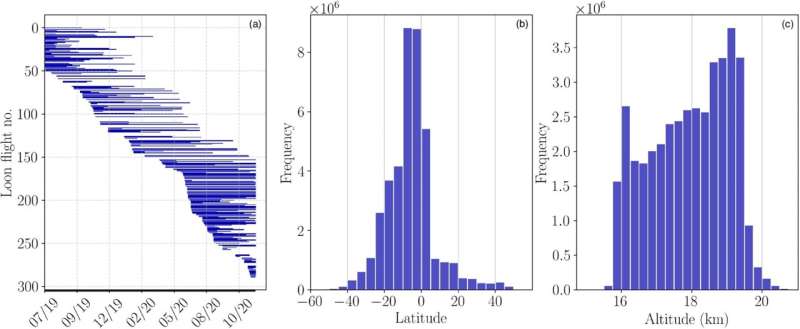
Stratospheric balloons confirm wind data from wind satellite Aeolus (Image Credit: Phys.org)

Future wind satellites should increase vertical resolution to better resolve gravity waves in the tropics, writes a team of researchers from the Leibniz Institute for Tropospheric Research (TROPOS), the European Space Agency (ESA), the European Centre for Medium-Range Weather Forecasts (ECMWF), the University of Hamburg and the Google company Loon. Their study has been published in the Quarterly Journal of the Royal Meteorological Society.
The quality of numerical weather prediction models and thus of weather forecasts depends heavily on available data. In recent decades, a global observation system has therefore been built up to also include wind profiles from weather balloons, aircraft data or wind profiler radar systems. However, most of this data comes from the densely populated Northern Hemisphere. In the Southern Hemisphere, over the oceans and especially in the tropics, the network of direct measurements is still relatively sparse.
The launch of the European Space Agency’s (ESA) first wind satellite Aeolus, on August 22, 2018, was a major step towards global wind measurements. This novel satellite has a powerful laser on board, the Atmospheric Laser Doppler Instrument (ALADIN). ALADIN is the first Doppler wind lidar in space to provide profiles of horizontal wind speed from Earth’s surface or from the top of thick clouds up to a height of about 30 km on a global scale.
To do this, the satellite emits short ultraviolet laser pulses as it orbits Earth. A small part of these light pulses is scattered back to the satellite by air molecules, aerosols and clouds, and collected and processed in the detector there. For one circumnavigation of the globe, Aeolus takes 90 minutes; within a week the satellite collects wind data around the entire globe.
This data is assimilated by weather forecasting centers around the world to improve their forecasts. Since there have been no comparable satellite missions so far, the data are checked particularly critically and compared with other wind measurements.
A study recently published used data from 229 stratospheric balloons of the Loon project between July 2019 and December 2020 from tropical regions of Latin America, the Atlantic Ocean, Africa and the Indian Ocean for comparison. Loon was a commercial project that had provided remote regions with internet access via helium balloons in the stratosphere. The balloons, which were about 12 meters in diameter, acted as floating mobile phone stations at altitudes of 16 to 20 kilometers above the ground.
For maintaining the network, the balloons had to automatically correct the wind direction by changing the altitude. This created an extensive data set on wind speeds in these atmospheric layers, which partially fills the gap in wind data at this altitude in the global observation system. The Loon project was discontinued in 2021 for economic reasons, but a highly interesting data set remains for atmospheric research.
“Our analysis confirms that the Aeolus satellite provides almost bias-free wind measurements in the upper troposphere and lower stratosphere. In contrast, the current ECWMF weather model systematically underestimates the wind speed there by about 1 meter per second, which could be demonstrated by the Aeolus and Loon data. These results are important to better understand dynamical processes in the upper troposphere and lower stratosphere and to further improve the weather models,” emphasizes Dr. Sebastian Bley from TROPOS, who worked on the study at ESA in Frascati, Italy.
Another recommendation of the researchers is to carry out more vertical measurements to be able to provide more wind information in the atmospheric layers. This could further improve the accuracy of upcoming wind satellites. In addition to wind speed, Aeolus also provides information about aerosols and clouds, but only via a portion of the backscattered light.
“We hope that future wind missions will also be able to measure depolarization, the rotation of light when it is reflected. That would be a milestone because the satellite could then also provide more information about aerosols,” explains Bley.
Aeolus was developed as an explorer mission with an expected lifetime of 3 years to demonstrate the technology of a Doppler wind lidar in space. However, the expectations were exceeded and Aeolus has now been providing valuable data for over 4 years.
The wind data are now used in the weather forecasts of several weather services throughout Europe, such as the German Weather Service (DWD), and have been convincing due to their positive influence on the quality of weather forecasts. The way forward for the follow-up mission Aeolus-2 has been recently decided in the ESA ministerial committee and will be jointly developed by ESA and EUMETSAT.
In September, researchers from the US integrated Aeolus data into the hurricane model (HWRF) of the US weather and oceanography agency NOAA on a trial basis in order to better predict tropical storms. Their conclusion is that the use of Aeolus wind data is most effective where there are no reconnaissance flights into the hurricanes and could therefore have the greatest positive impact on tropical cyclone forecasting in the Pacific and Indian Oceans.
More information:
Sebastian Bley et al, Validation of the Aeolus L2B Rayleigh winds and ECMWF short‐range forecasts in the upper troposphere and lower stratosphere using Loon super pressure balloon observations, Quarterly Journal of the Royal Meteorological Society (2022). DOI: 10.1002/qj.4391
Provided by
Leibniz-Institut für Troposphärenforschung e. V.
Stratospheric balloons confirm wind data from wind satellite Aeolus (2022, December 20)
retrieved 21 December 2022
from https://phys.org/news/2022-12-stratospheric-balloons-satellite-aeolus.html
part may be reproduced without the written permission. The content is provided for information purposes only.





